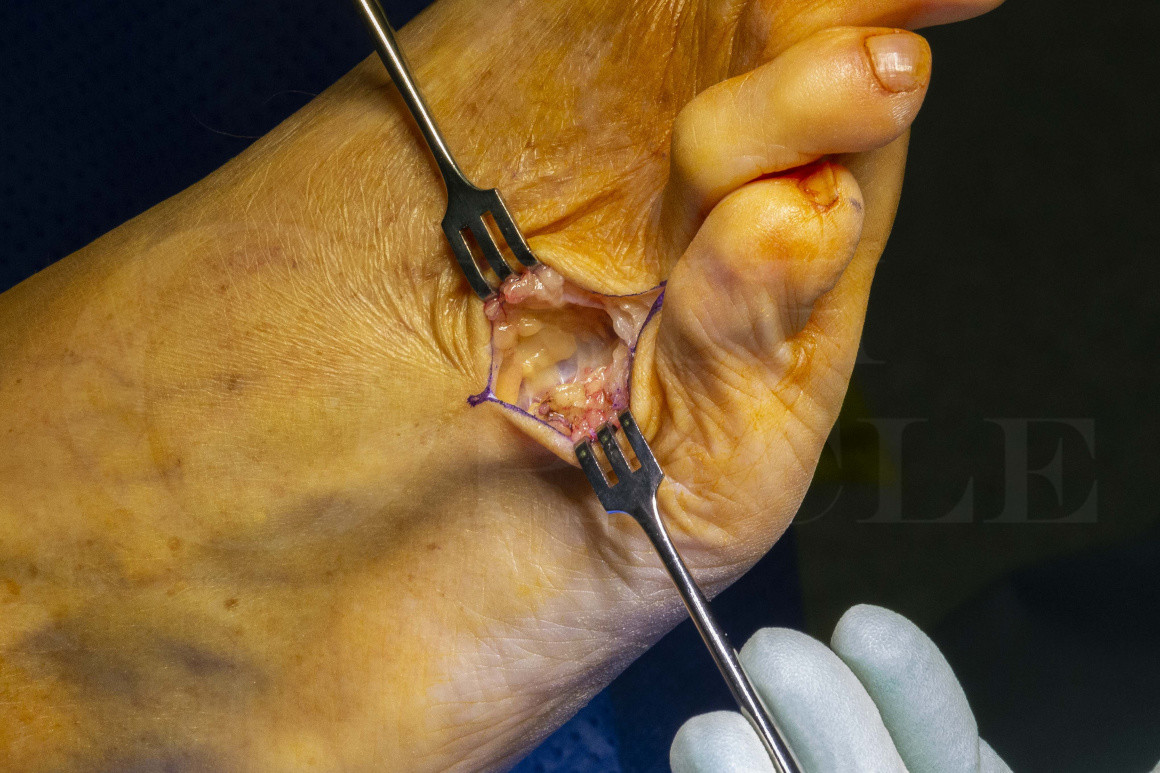Hammer toe deformity: soft tissue correction
Overview

Subscribe to get full access to this operation and the extensive Foot Surgery Atlas.
Learn the Hammer toe deformity: soft tissue correction surgical technique with step by step instructions on OrthOracle. Our e-learning platform contains high resolution images and a certified CME of the Hammer toe deformity: soft tissue correction surgical procedure.
Lesser toe deformities and hammer toes are commonly occurring conditions that can be associated with significant symptomatology and morbidity. The metatarsal heads take a significant proportion of the body weight during the gait cycle, especially push off. The lesser toes do, however, play an important role in increasing the surface area and load-sharing with the metatarsal heads during weight bearing, this can only occur if the toes remain in contact with the ground during gait.
In the normal foot the toes are in contact with the ground during the late second and third rockers of gait. The function of the lesser toes relies on a complex balance between the extensor apparatus, the flexors, the intrinsic foot muscles and the plantar fascia(via the plantar plates). The extensor digitorum longus passes dorsal to the metatarso-phangeal joint (MTP joint), quite centrally and is joined by the extensor digitorum brevis (EDB) which passes laterally (although in the 5th toe, the EDB is often absent). The central slip of the extensor apparatus inserts into the middle phalanx and the two lateral slips pass on to the distal phalanx. The proximal phalanx does not have a direct insertion from an extensor tendon, however, the extensors form a sling like structure which encircles the MTP joint and attaches to the plantar plate.
The intrinsic muscles are able to act through this extensor sling. The interossei pass dorsal to the deep transverse ligament either side of the MTP joint and insert onto the proximal phalanx, they act as extensors of the MTPJ and, via the sling, the IP joints. The lumbricals pass plantar to the transverse metatarsal ligament, and thus act as flexors of the MTPJ.
Various anatomical studies including Sarrafian, found that there was a complex interaction of forces responsible for lesser toe function, most of the force from The extensor digitorum longus (EDL) passed through the extensor sling to the MTP joint. They found that the interphalangeal joints could only be extended when the MTP joint was neutral or flexed downwards. The plantar fascia further acts to flex the MTP joints in the loaded position; as load is passed through the foot, the calcaneum and metatarsal heads have a tendency to pull apart from each other, increasing tension within the slips of the plantar fascia, with a resultant strong plantar flexion of the MTP joint, a mechanism known as the reverse windless mechanism.
Deformity can result following any cause of imbalance between the extensor and flexor forces around the toes. This can be caused by trauma, chronic injury to the plantar plate, degenerative change, instability in the metatarsophalangeal joint and muscle weakness creating an imbalance between the intrinsic and extrinsic muscles. There appears to be a significant hereditary incidence of lesser toe deformities. Hammer toe deformities can also be the result of transfer metatarsalgia and is associated with disorders of the first ray most commonly, hallux valgus deformity.
This procedure concentrates purely on the soft tissue correction of MTPJ deformity, in many cases this will be performed along with procedures to correct associated toe deformities. The dorsiflexed MTPJ is often the result of a dosrsal contracture of the EDL tendon and often the dorsal capsule of the joint, occasionally the collateral ligaments. The soft tissue release we describes presents a sequential release of these structures to correct the deformity.
OrthOracle readers will also find of interest the following associated operative techniques:
Crossover second toe deformity: Extensor Digitorum Brevis transfer
Weils osteotomy (using Othosolutions forefoot reconstruction system, FRS)
Congenital curly fifth toe correction
Claw toe correction: Jones procedure and Hansens flexor hallucis longus transfer
Author: Nick Cullen FRCS(Tr & Orth)
Institution: The Royal National Orthopaedic Hospital, Stanmore, London.
Clinicians should seek clarification on whether any implant demonstrated is licensed for use in their own country.
In the USA contact: fda.gov
In the UK contact: gov.uk
In the EU contact: ema.europa.eu
Online learning is only available to subscribers.



















